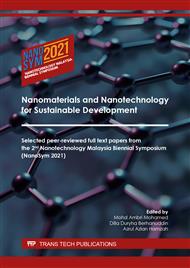[1]
D. Sandi, A. Supriyanto, and Y. Iriani, The effects of sintering temperature on dielectric constant of barium titanate (BaTiO3),, in IOP Conference Series: Materials Science and Engineering, 2016, vol. 107, no. 1: IOP Publishing, p.012069.
DOI: 10.1088/1757-899x/107/1/012069
Google Scholar
[2]
M. A. Siddiqui, F. Hussain, M. S. Hanif, A. A. Mohamad, and M. Tufail, Effect of Calcination and Sintering Temperatures on Physical Properties of Barium Titanate Ceramic,, Int. J. Electroactive Mater, vol. 6, pp.42-47, (2018).
Google Scholar
[3]
H. Qian et al., Preparation of tetragonal barium titanate nanopowders by microwave solid-state synthesis,, Applied Physics A, vol. 126, no. 4, pp.1-9, (2020).
Google Scholar
[4]
M. Acosta et al., BaTiO3-based piezoelectrics: Fundamentals, current status, and perspectives,, Applied Physics Reviews, vol. 4, no. 4, p.041305, (2017).
Google Scholar
[5]
F. Ismail, R. A. M. Osman, M. S. Idris, and N. Ahmad Hambali, Structure and electrical characteristics of BaTiO3 and Ba0. 99Er0. 01TiO3 Ceramics,, in Solid State Phenomena, 2018, vol. 280: Trans Tech Publ, pp.127-133.
Google Scholar
[6]
S. Sharma, S. Thakur, and N. Negi, Effect of Sintering Temperature on Structural, Micro Structural Dielectric and Electric Properties of Ca Doped Lead Free BaTiO3 Ceramic,, Integrated Ferroelectrics, vol. 203, no. 1, pp.52-57, (2019).
DOI: 10.1080/10584587.2019.1674954
Google Scholar
[7]
Z. Liu et al., Effect of ZnO on the microstructure and dielectric properties of BaTiO3 ceramic coatings prepared by plasma spraying,, Journal of Alloys and Compounds, vol. 727, pp.696-705, (2017).
DOI: 10.1016/j.jallcom.2017.08.175
Google Scholar
[8]
X. Wang et al., Effects of Calcining Temperature on Structure and Dielectric and Ferroelectric Properties of Sol-Gel Synthesized Ba 0.85 Ca 0.15 Zr 0.1 Ti 0.9 O 3 Ceramics,, Journal of Electronic Materials, vol. 49, no. 1, pp.880-887, (2020).
DOI: 10.1007/s11664-019-07769-4
Google Scholar
[9]
W. Li, Z. Xu, R. Chu, P. Fu, and J. Hao, Structure and electrical properties of BaTiO3 prepared by sol–gel process,, Journal of alloys and compounds, vol. 482, no. 1-2, pp.137-140, (2009).
DOI: 10.1016/j.jallcom.2009.02.137
Google Scholar
[10]
N. Buatip et al., Investigation on electrical properties of BCZT ferroelectric ceramics prepared at various sintering conditions,, Integrated Ferroelectrics, vol. 187, no. 1, pp.45-52, (2018).
DOI: 10.1080/10584587.2018.1445395
Google Scholar
[11]
N. M. Zali, C. S. Mahmood, S. M. Mohamad, C. T. Foo, and J. A. Murshidi, X-ray diffraction study of crystalline barium titanate ceramics,, in AIP Conference proceedings, 2014, vol. 1584, no. 1: American Institute of Physics, pp.160-163.
DOI: 10.1063/1.4866124
Google Scholar
[12]
A. T. H Msouni, M El Aatmani, D Fasquelle, J C Carru, M El Hammioui, M Rguiti, A Zegzouti, A Outzourhit & M Daoud Structural, dielectric and piezoelectric study of Ca-, Zr-modified BaTiO3 lead-free ceramics,, Bulletin of Materials Science, vol. 40, p.925–931, (2017).
DOI: 10.1007/s12034-017-1445-6
Google Scholar
[13]
A. Reyes-Montero, P. Ramos-Alvarez, A.M. González, R. López-Juárez, and M. E. Villafuerte-Castrejón, Dielectric and impedance analysis on the electrical response of lead-free Ba1− xCaxTi0. 9Zr0. 1O3 ceramics at high temperature range,, Applied Sciences, vol. 7, no. 3, p.214, (2017).
DOI: 10.3390/app7030214
Google Scholar
[14]
J.P. Praveen, K. Kumar, C. James Raju, and D. Das, A study of piezoelectric properties of (Ba 0.85 Ca 0.15)(Zr 0.9 Ti 0.1) O 3 ceramics synthesized by sol-gel process,, in AIP conference proceedings, 2013, vol. 1536, no. 1: American Institute of Physics, pp.891-892.
DOI: 10.1063/1.4810515
Google Scholar
[15]
X. Ji et al., Structure and electrical properties of BCZT ceramics derived from microwave-assisted sol-gel-hydrothermal synthesized powders,, Scientific Reports, vol. 10, no. 1, pp.1-8, (2020).
DOI: 10.1038/s41598-020-73784-9
Google Scholar


